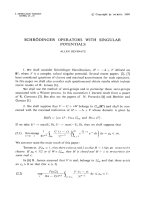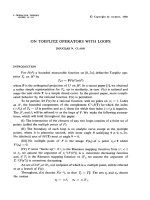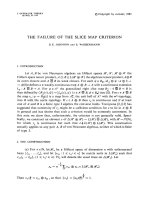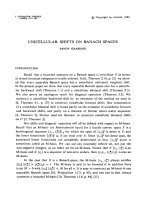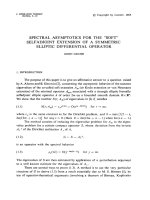Báo cáo toán học: "he map asymptotics constant tg" ppsx
Bạn đang xem bản rút gọn của tài liệu. Xem và tải ngay bản đầy đủ của tài liệu tại đây (104.14 KB, 9 trang )
The map asymptotics constant t
g
Edward A. Bender
Department of Mathematics
University of California, San Diego
La Jolla, CA 92093-0112
Zhicheng Gao
∗
School of Mathematics and Statistics
Carleton University
Ottawa, Ontario K1S5B6
Canada
L. Bruce Richmond
†
Department of Combinatorics and Optimization
University of Waterloo
Waterloo, Ontario N2L 3G1
Canada
Submitted: Jan 28, 2008; Accepted: Mar 22, 2008; Published: Mar 27, 2008
Mathematics Subject Classification: 05C30
Abstract
The constant t
g
appears in the asymptotic formulas for a variety of rooted maps
on the orientable surface of genus g. Heretofore, studying this constant has been
difficult. A new recursion derived by Goulden and Jackson for rooted cubic maps
provides a much simpler recursion for t
g
that leads to estimates for its asymptotics.
1 Introduction
Let Σ
g
be the orientable surface of genus g. A map on Σ
g
is a graph G embedded on Σ
g
such that all components of Σ
g
−G are simply connected regions. These components are
called faces of the map. A map is rooted by distinguishing an edge, an end vertex of the
edge and a side of the edge.
With M
n,g
the number of rooted maps on Σ
g
with n edges, Bender and Canfield [1]
showed that
M
n,g
∼ t
g
n
5(g−1)/2
12
n
as n → ∞, (1)
∗
Research supported by NSERC
†
Research supported by NSERC
the electronic journal of combinatorics 15 (2008), #R51 1
where the t
g
are positive constants which can be calculated recursively using a complicated
recursion involving, in addition to g, many other parameters. The first three values are
t
0
=
2
√
π
, t
1
=
1
24
and t
2
=
7
4320
√
π
.
Gao [3] showed that many other interesting families of maps also satisfy asymptotic for-
mulas of the form
αt
g
(βn)
5(g−1)/2
γ
n
(2)
and presented a table of α, β and γ for eleven families. Richmond and Wormald [5]
showed that many families of unrooted maps have asymptotics that differ from the rooted
asymptotics by a factor of four times the number of edges. See Goulden and Jackson [4]
for a discussion of connections with mathematical physics.
Although α, β and γ in (2) seem relatively easy to compute, the common factor t
g
has been difficult to study. A recursion for rooted “cubic” maps derived by Goulden and
Jackson [4] leads to a much simpler recursion for t
g
than that in [1]. We will use it to
derive the following recursion and asymptotic estimate for t
g
.
Theorem 1 Define u
g
by u
1
= 1/10 and
u
g
= u
g−1
+
g−1
h=1
1
R
1
(g, h)R
2
(g, h)
u
h
u
g−h
for g ≥ 2, (3)
where
R
1
(g, h) =
[1/5]
g
[1/5]
h
[1/5]
g−h
, R
2
(g, h) =
[4/5]
g−1
[4/5]
h−1
[4/5]
g−h−1
and [x]
k
is the rising factorial x(x + 1) ···(x + k − 1). Then
t
g
= 8
[1/5]
g
[4/5]
g−1
Γ
5g−1
2
25
96
g
u
g
∼
40 sin(π/5)K
√
2π
1440g
e
−g/2
as g → ∞, (4)
where u
g
∼ K
.
= 0.1034 is a constant.
2 Cubic Maps
A map is called cubic if all its vertices have degree 3. The dual of cubic maps are called
triangular maps whose faces all have degree 3. Let T
n,g
be the number of triangular maps
on Σ
g
with n vertices and let C
n,g
be the number of cubic maps on Σ
g
with 2n vertices.
It was shown in [2] that
T
n,g
∼ 3
3
7
× 2
9
(g−1)/2
t
g
n
5(g−1)/2
(12
√
3)
n
as n → ∞. (5)
the electronic journal of combinatorics 15 (2008), #R51 2
Since a triangular map on Σ
g
with v vertices has exactly 2(v + 2g − 2) faces,
C
n,g
= T
n−2g+2,g
∼ 3 × 6
(g−1)/2
t
g
n
5(g−1)/2
(12
√
3)
n
as n → ∞. (6)
Define
H
n,g
= (3n + 2)C
n,g
for n ≥ 1, (7)
H
−1,0
= 1/2, H
0,0
= 2 and H
−1,g
= H
0,g
= 0 for g = 0.
Goulden and Jackson [4] derived the following recursion for (n, g) = (−1, 0):
H
n,g
=
4(3n + 2)
n + 1
n(3n − 2)H
n−2,g−1
+
n−1
i=−1
g
h=0
H
i,h
H
n−2−i,g−h
. (8)
This is significantly simpler than the recursion derived in [2]. We will use it to derive
information about t
g
.
3 Generating Functions
Define the generating functions
T
g
(x) =
n≥0
T
n,g
x
n
, C
g
(x) =
n≥0
C
n,g
x
n
, H
g
(x) =
n≥0
H
n,g
x
n
and F
g
(x) = x
2
H
g
(x).
It was shown in [2] that T
g
(x) is algebraic for each g ≥ 0, and
T
0
(x) =
1
2
t
3
(1 − t)(1 −4t + 2t
2
) with x =
1
2
t(1 − t)(1 −2t), (9)
where t = t(x) is a power series in x with non-negative coefficients.
It follows from (6) and (7) that
C
g
(x) = x
2g−2
T
g
(x) for g ≥ 0, (10)
F
g
(x) = 3x
3
C
g
(x) + 2x
2
C
g
(x) for g ≥ 1. (11)
We also have
F
0
(x) = H
0,0
x
2
+
n≥1
(3n + 2)C
n,0
x
n+2
= 2x
2
+ 3x
3
C
0
(x) + 2x
2
C
0
(x)
= 2x
2
+ 3xT
0
(x) − 4T
0
(x)
=
1
2
t
2
(1 − t), (12)
where we have used (9). Hence C
g
(x) and F
g
(x) are both algebraic for all g ≥ 0.
the electronic journal of combinatorics 15 (2008), #R51 3
In the following we assume g ≥ 1. From the recursion (8), we have
1
4
n≥0
n + 1
3n + 2
H
n,g
x
n
=
n≥1
n(3n − 2)H
n−2,g−1
x
n
+ 2
n≥0
H
−1,0
H
n−1,g
x
n
+ x
2
g
h=0
H
h
(x)H
g−h
(x).
Using (7) with a bit manipulation, we can rewrite the above equation as
1
4
n≥0
(n + 1)C
n,g
x
n
= 3x
2
F
g−1
(x) + xF
g−1
(x) + xH
−1,g−1
+ x
−1
F
g
(x) + x
−2
g
h=0
F
h
(x)F
g−h
(x).
With δ
i,j
the Kronecker delta, this becomes
x
3
C
g
(x) + x
2
C
g
(x) = 12x
4
F
g−1
(x) + 4x
3
F
g−1
(x) + 2x
3
δ
g,1
+ 4xF
g
(x) + 8F
0
(x)F
g
(x) + 4
g−1
h=1
F
h
(x)F
g−h
(x).
It follows from (11) that
(1 − 12x −24F
0
(x)) F
g
(x) = 36x
4
F
g−1
(x) + 12x
3
F
g−1
(x) + 6x
3
δ
g,1
+ 12
g−1
h=1
F
h
(x)F
g−h
(x) − x
2
C
g
(x). (13)
Substituting (12) and (9) into (13), we obtain
F
g
(x) =
1
1 − 6t + 6t
2
36x
4
F
g−1
(x) + 12x
3
F
g−1
(x) + 6x
3
δ
g,1
+ 12
g−1
h=1
F
h
(x)F
g−h
(x) − x
2
C
g
(x)
. (14)
We now show that this equation can be used to calculate C
g
(x) more easily than the
method in [2]. For this purpose we set s = 1 − 6t + 6t
2
and show inductively that C
g
(x)
is a polynomial in s divided by s
a
for some integer a = a(g) > 0. (It can be shown that
a = 5g −3 is the smallest such a, but we do not do so.) The method for calculating C
g
(x)
follows from the proof. Then we have
x
2
=
1
432
(s − 1)
2
(2s + 1) and
ds
dx
=
144x
s(s − 1)
. (15)
Thus
x
d
dx
= x
ds
dx
d
ds
=
(s − 1)(2s + 1)
3s
d
ds
,
d
2
dx
2
=
ds
dx
2
d
2
ds
2
+
d(ds/dx)
dx
d
ds
=
48(2s + 1)
s
2
d
2
ds
2
−
48(s + 1)
s
3
d
ds
.
the electronic journal of combinatorics 15 (2008), #R51 4
From the above and (11)
F
g
(x) +
x
2
C
g
1 − 6t + 6t
2
= x
2
3x
dC
g
dx
+
(2s + 1)C
g
s
=
x
2
(2s + 1)
s
d((s − 1)C
g
)
ds
.
With some algebra, (14) can be rewritten as
d((s − 1)C
g
)
ds
=
4(s − 1)
2
(2s + 1)
s
2
d
2
F
g−1
ds
2
+
4(s − 1)
s
3
dF
g−1
ds
+
5184
(s − 1)
2
(2s + 1)
2
g−1
h=1
F
h
F
g−h
for g ≥ 2. (16)
In what follows P (s) stands for a polynomial in s and a a positive integer, both
different at each occurrence. It was shown in [2] that
C
1
(x) = T
1
(x) =
1 − s
12s
2
.
By (11), (15) and the induction hypothesis, the right hand side of (16) has the form
P (s)/s
a
. Integrating, (s − 1)C
g
= P (s)/s
a
+ K log s. Since we know C
g
(x) is algebraic,
so is (s − 1)C
g
and hence K = 0. Since s = 1 corresponds to x = 0, C
g
is defined there.
It follows that P (s) in (s −1)C
g
= P (s)/s
a
is divisible by s − 1, completing the proof.
Using Maple, we obtained
C
2
=
1
2
6
3
4
(2s + 1)(17s
2
+ 60s + 28)(1 − s)
3
s
7
,
C
3
=
1
2
9
3
8
(5052s
4
− 747s
3
− 33960s
2
− 35620s − 9800)(2s + 1)
2
(s − 1)
5
s
12
,
C
4
=
1
2
14
3
11
P
4
(s)(2s + 1)
3
(s − 1)
7
s
17
,
C
5
=
1
2
17
3
14
P
5
(s)(2s + 1)
4
(1 − s)
9
s
22
,
where
P
4
(s) = −12458544 − 63378560s − 103689240s
2
− 42864016s
3
+ 31477893s
4
+ 20750256s
5
+ 417636s
6
,
P
5
(s) = 7703740800 + 50294009360s + 117178660480s
2
+ 100386081272s
3
− 16827627792s
4
− 67700509763s
5
− 21455389524s
6
+ 4711813020s
7
+ 1394857272s
8
.
4 Generating Function Asymptotics
Suppose A(x) is an algebraic function and has the following asymptotic expansion around
its dominant singularity 1/r:
A(x) =
k
j=l
a
j
(1 − rx)
j/2
+ O
(1 − rx)
(k+1)/2
,
the electronic journal of combinatorics 15 (2008), #R51 5
where a
j
are not all zero. Then we write
A(x) ≈
k
j=l
a
j
(1 − rx)
j/2
.
The following lemma is proved in [2].
Lemma 1 For g ≥ 0, T
g
(x) is algebraic,
T
0
(x) ≈
√
3
72
−
5
216
+
1
54
√
6
(1 − 12
√
3x)
3/2
,
T
g
(x) ≈ 3
3
7
× 2
9
(g−1)/2
t
g
Γ
5g − 3
2
(1 − 12
√
3x)
−(5g−3)/2
for g ≥ 1.
Let
f
g
= 24
−3/2
6
g/2
Γ
5g − 1
2
t
g
. (17)
Using Lemma 1, (10) and (11), we obtain
C
g
(x) ≈
288
(5g − 3)
f
g
(1 − 12
√
3x)
−(5g−3)/2
for g ≥ 1,
F
g
(x) ≈ f
g
(1 − 12
√
3x)
−(5g−1)/2
for g ≥ 1.
As noted in [2], the function t(x) of (9) has the following asymptotic expansion around
its dominant singularity x =
1
12
√
3
:
t ≈
3 −
√
3
6
−
√
2
6
(1 − 12
√
3x)
1/2
.
Using this and (12), we obtain
F
0
(x) ≈
3 −
√
3
72
+ f
0
(1 − 12
√
3x)
1/2
,
1
1 − 6t + 6t
2
≈
√
6
2
(1 − 12
√
3x)
−1/2
.
Comparing the coefficients of (1 − 12
√
3x)
(5g−1)/2
on both sides of (14), we obtain
f
g
=
√
6
96
(5g − 4)(5g − 6)f
g−1
+ 6
√
6
g−1
h=1
f
h
f
g−h
. (18)
Letting
u
g
= f
g
25
√
6
96
−g
6
√
6
[1/5]
g
[4/5]
g−1
.
and using (17), the recursion (18) becomes (3).
the electronic journal of combinatorics 15 (2008), #R51 6
5 Asymptotics of t
g
It follows immediately from (3) that u
g
≥ u
g−1
for all g ≥ 2. To show that u
g
approaches
a limit K as g → ∞, it suffices to show that u
g
is bounded above. The value of K is then
calculated using (3).
We use induction to prove u
g
≤ 1 for all g ≥ 1. Since u
1
=
1
10
and u
2
= u
1
+
1
480
, we
can assume g ≥ 3 for the induction step. From now on g ≥ 3.
Note that
R
1
(g, 1)R
2
(g, 1) = 5(g −
4
5
)(g −
6
5
) > 5(g −
4
5
)(g −
9
5
)
R
1
(g, 2)R
2
(g, 2) =
25
24
(g −
6
5
)(g −
11
5
)
5(g −
4
5
)(g −
9
5
)
>
25
24
(g −
6
5
+
4
5
)(g −
11
5
−
4
5
)
5(g −
4
5
)(g −
9
5
)
≥ 2(g − 3)
5(g −
4
5
)(g −
9
5
)
.
Note that R
i
(g, h) = R
i
(g, g − h) and, for h < g/2,
R
i
(g,h+1)
R
i
(g,h)
≥ 1. Combining all these
observations and the induction hypothesis with (3) we have
u
g
= u
g−1
+
g−1
h=1
u
h
u
g−h
R
1
(g, h)R
2
(g, h)
< u
g−1
+
2u
1
u
g−1
5(g −
4
5
)(g −
9
5
)
+
g−2
h=2
1
R
1
(g, 2)R
2
(g, 2)
< u
g−1
+
1/5
5(g −
4
5
)(g −
9
5
)
+
1/2
5(g −
4
5
)(g −
9
5
)
< u
g−1
+
1
5g − 9
−
1
5g − 4
.
Hence
u
g
< u
2
+
g
k=3
1
5k − 9
−
1
5k − 4
< u
2
+
1
5 × 3 − 9
< 1.
The asymptotic expression for t
g
in (4) is obtained by using
[x]
k
=
Γ(x + k)
Γ(x)
, Γ(1/5)Γ(4/5) =
π
sin(π/5)
,
and Stirling’s formula
Γ(ag + b) ∼
√
2π(ag)
b−1/2
ag
e
ag
as g → ∞,
for constants a > 0 and b.
the electronic journal of combinatorics 15 (2008), #R51 7
6 Open Questions
We list some open questions.
• From (18), we can show that f(z) =
g≥1
f
g
z
g
satisfies the following differential
equation
f(z) = 72
√
6(f(z))
2
+
√
6
96
z
25z
2
f
(z) + 25zf
(z) − f(z) −
√
6
72
.
The asymptotic expression of f
g
implies that f(z) cannot be algebraic. Can one
show that f(z) is not D-finite, that is, f (z) does not satisfy a linear differential
equation?
• There is a constant p
g
that plays a role for maps on non-orientable like t
g
plays
for maps on orientable surfaces [3]. Is there a recursion for maps on non-orientable
surfaces that can be used to derive a theorem akin to Theorem 1 for p
g
?
• Find simple recursions akin to (8) for other classes of rooted maps that lead to
simple recursive calculations of their generating functions as in (16).
References
[1] E.A. Bender and E.R. Canfield, The asymptotic number of maps on a surface, J.
Combin. Theory, Ser. A, 43 (1986), 244–257.
[2] Z.C. Gao, The Number of Rooted Triangular Maps on a Surface, J. Combin. Theory,
Ser. B, 52 (1991), 236–249.
[3] Z.C. Gao, A Pattern for the Asymptotic Number of Rooted Maps on Surfaces, J.
Combin. Theory, Ser. A, 64 (1993), 246–264.
[4] I. Goulden and D.M. Jackson, The KP hierarchy, branched covers and triangulations,
preprint (2008).
[5] L.B. Richmond and N.C. Wormald, Almost all maps are asymmetric, J. Combin.
Theory, Ser. B, 63 (1995), 1–7.
the electronic journal of combinatorics 15 (2008), #R51 8
Corrigendum – submitted Jul 28, 2008
The last displayed equation in the paper contains two incorrect coefficients, namely the
first and last. The correct equation is
f(z) = 6
√
6(f(z))
2
+
√
6
96
z
25z
2
f
(z) + 25zf
(z) − f(z) +
√
6
72
.
the electronic journal of combinatorics 15 (2008), #R51 9

